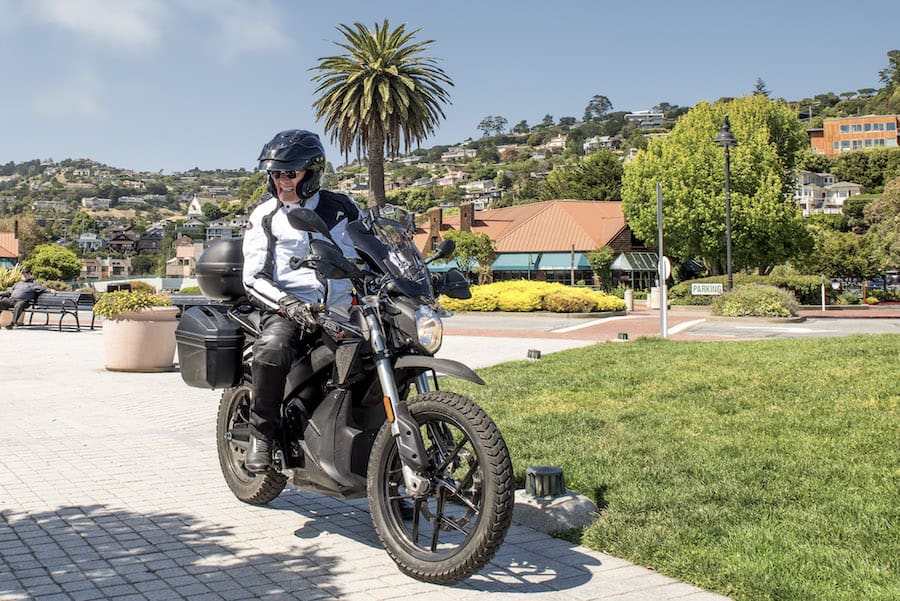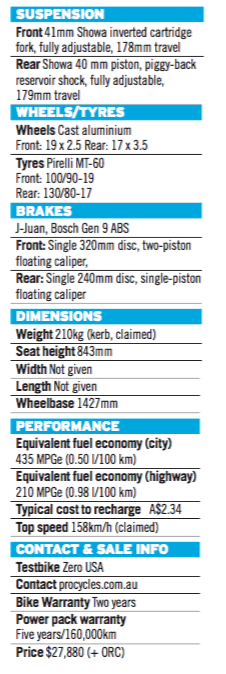Sales of electric motorcycles are on the rise, as improvements in range and charging time make them ever more appealing. But it’s one thing to swish along enjoying the sound of silence on your daily commute to and from work, and quite another to do serious mileage – isn’t it? Like, making a week’s tour of northern California. Yet that’s just what I did aboard a 2016 Zero DSR.
I’ve been riding each new Zero model for the past six years and have seen the gradual improvements. For 2016, energy density was boosted, giving models with the PowerTank supplementary battery a claimed 317km range in urban use, or 158km at 113km/h on the highway, and a combined city/highway range of 174km – the first time this has exceeded 160km on any Zero model. Backed up by a powertrain delivering more mumbo, this was a zero-emissions bike that could take you to faraway places.
But seeing is believing, so I dared the Zero team to put their claims to the test by lending me a bike for a 1500km tour of Northern California. They happily supplied a 2016 Zero DSR retailing at $22,990 (+ORC), rising to $27,880 fitted with the optional PowerTank. Remember, the higher cost compared to a conventional motorcycle is offset by these being zero maintenance products. Apart from replacing brake pads and tyres, and the Gates drive belt (that’s now good for 40,000km), you should never again visit your dealer.
Zero also provided a topbox containing two Elcon 2.5kWh chargers coupled to deliver six times the charging speed of the 1.3kWh standard on-board charger. “This is the maximum speed charger you can safely run off any standard 110V US wall outlet, and is all most customers ever need, since they recharge the bike overnight or at work,” said Todd Andersen, Zero’s VP of Marketing & Sales. “But you’re going touring and don’t want to spend all day charging the battery, so we’ve hopped things up.”
This allowed me to use the same CHAdeMO hookup as the now common Toyota Prius. This can recharge the Zero’s combined 15.9kWh battery pack from 5 per cent to 95 per cent in two and a half hours, against 12 hours from a household socket.
I’d need proof of my travels, so snapper mate Phil Hawkins accompanied me on his Triumph Tiger 800XC. The added benefit was he theoretically could push the Zero via a footpeg to the nearest hook-up if I ever ran out of ‘gas’! But how do you find the charging stations? That’s easy, just visit www.plugshare.com. It lists all available charging locations, from public ChargePoints to behind-the-house outlets that people make available to EV travellers, along with a cup of coffee while they’re waiting.
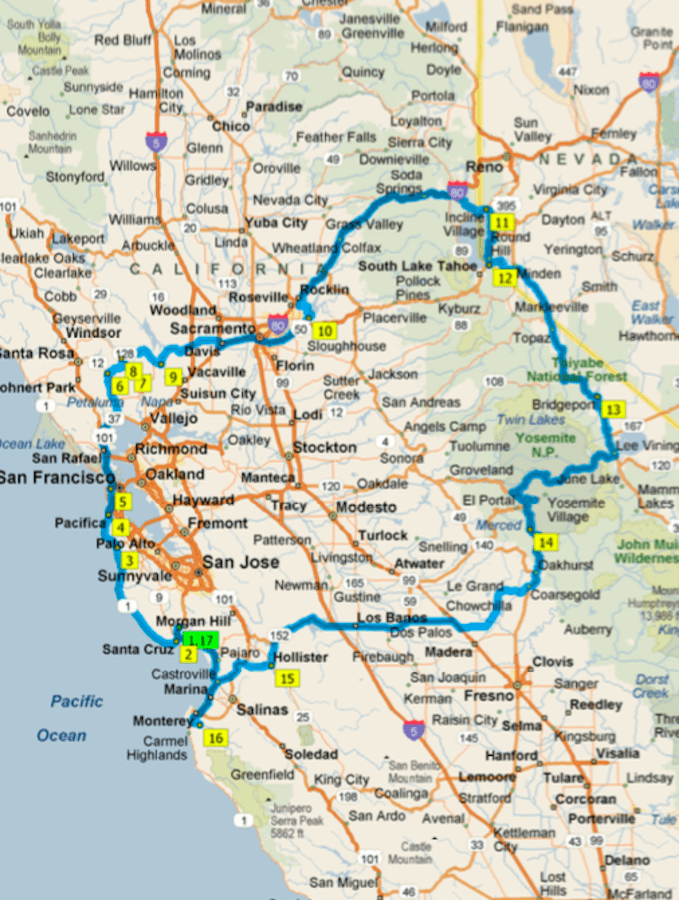
DAY 1
Charge!
At the Zero factory I was given the keys to a sinister-looking all-black DSR – and some valuable advice from e-touring veteran Terry Hershner. In May 2015, Terry became the first electric motorcyclist to ride 300 miles (482km) on a single charge, carrying 27kWh of battery aboard his Zero (more than a Nissan Leaf electric car). “You must plan your trips more strategically,” he warned. “Try to plan ahead so you have lunch while you’re topping up, or maybe take in some sightseeing. And never miss a chance to top up, even just for a few minutes – you may regret it later if you don’t.”
I took Terry’s advice and plugged in for a free top-up after the first 80km of snaking silently up through the redwood forests to Skyline Drive, the Bay Area’s racer road. The ride took us through small logging towns whose main income is speeding tickets, but crawling through these at near-walking pace was no handicap on the Zero as I could hear it was for Phil on his Triumph behind me. There was, however, another hazard – pedestrians who step out in front of you because they can’t hear you coming! The only sound the Zero makes at slow speed comes from muted tyre roar and a subdued whine from the transmission. Fortunately, the J.Juan brakes worked well in stopping the 210kg stock motorcycle without locking the front wheel, thanks to the Bosch ABS fitted as standard.
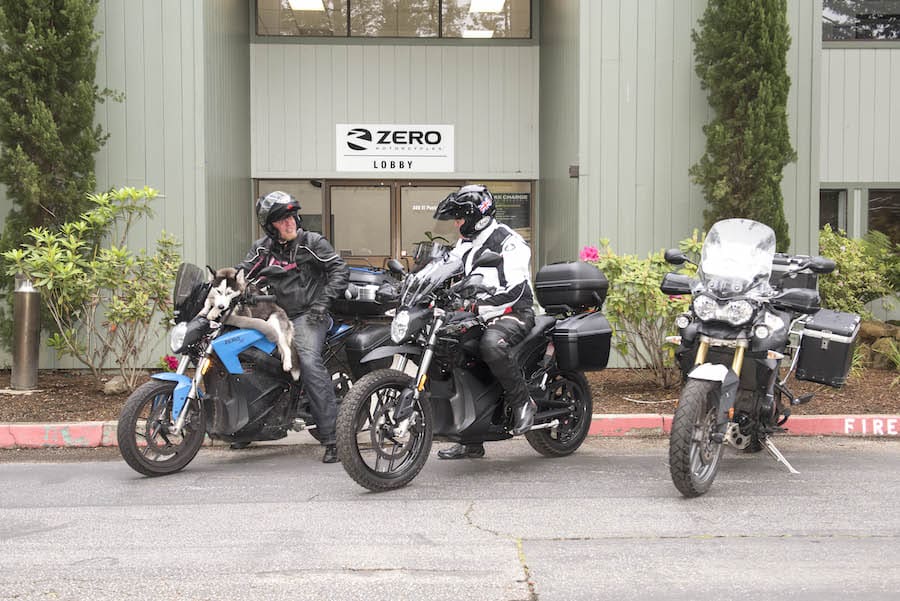
There are three different riding modes. Eco limits top speed to 70mph (112.7km/h), has gentle acceleration and quite heavy regenerative braking as displayed on the dash when you back off the throttle. Sport is what it promises, with vivid acceleration and zero regen. It lets you keep up turn speed to flow through a series of bends and won’t rob you of momentum via what amounts to engine braking. And the Custom map can be tailored via the Zero smartphone app. The one on the DSR had maxed-out drive that would lift the front wheel slightly, coupled with full regen – fine for descending winding roads.
With a full battery I dropped down to the scenic Pacific Coast and headed north to San Francisco, where we stopped for lunch at the Presidio, a former Spanish military base. Today, there’s been some tasteful redevelopment of the old barracks into private housing, with great views of the Golden Gate Bridge. I hooked up the Zero at the EV Center for a one-time $1.50 charge while we ate.
We had a dinner reservation at Mustard’s Grill – a popular Napa Valley restaurant with a good selection of local wines. And after covering 292km that first day we felt we’d earned it. Just five minutes from the restaurant was our overnight stop, chosen because it had two free EV hook-ups to recharge the Zero. The hotel shuttle bus took us to Mustard’s and back, by which time the bike had a full charge and I removed it from the space to let someone else power up.
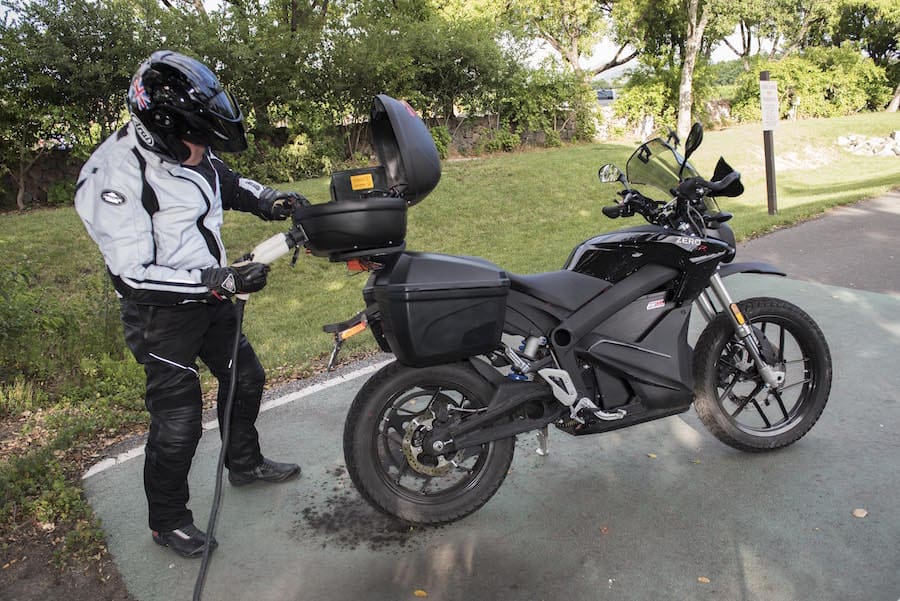
DAY 2
Highs and lows
Time to head to Sacramento, a 110km ride along the hilly, twisting Highway 129, a wonderful bikers’ road which had me appreciating the Zero DSR’s improbably good handling in spite of being weighed down by batteries.
Once there we discovered that rush hour begins early in California. Even at 3pm the freeways were crowded. Luckily, lane-filtering is a cinch on the Zero – you just twist, go or brake. Before heading up the mountain pass to overnight at Lake Tahoe, we hooked up at a ChargePoint in the town of Placerville, but on one of my frequent recharge checks I saw the station had packed up – and I was only at 84 per cent! The sun was going down, and we had to leave, so selecting Evo mode I set off behind Phil’s Triumph, trying to get extra range by slipstreaming him. We were now on US50, the legendary transcontinental highway built in 1926 linking California with Maryland – and had to crest Echo Summit, its highest point in California at 2250m, before dropping down to Lake Tahoe.
By now it was dark, and the road was so steep I couldn’t always use Evo mode because it reduced torque so much that the fully loaded bike occasionally just lost momentum. Hoping I’d at least reach the summit before running out of charge, and could then coast down to Tahoe, I selected Sport but backed off the throttle, and crouched down behind the DSR’s narrow screen to try and minimise wind resistance. Even so, the charge needle plummeted as we climbed ever higher – I was down to just seven per cent when we crested the summit to see the lights of Lake Tahoe beneath us. We still had another 24km to go to the lakeside hotel, and the range on the dash read only 19km. Better get your foot ready to push me, Phil!
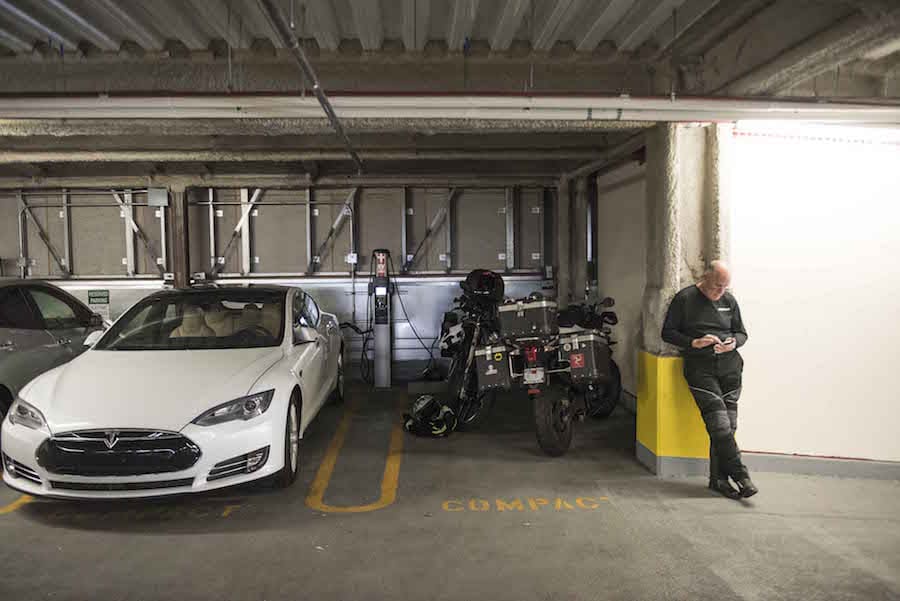
Regen to the rescue. The regenerative braking dialled in to the Zero’s controller has two different modes. One comes into play when you simply back off the throttle, and you can indeed feel some residual ‘engine braking’ and watch the dash recording it when you do so. But there’s also a sensor which monitors using either brake lever (foot or hand) and dials in additional regen. Coasting down US50’s steep 335m descent I watched the available charge on the DSR’s dash start to gain numbers, until by the time I was down on the valley floor and had to start using the throttle again I had 13 per cent charge, enough to make the hotel. I rolled in there after a 307km day with just 7 per cent charge left – you do the maths.
We’d chosen the Marriott Hotel because it offered free recharging hook-ups in its basement garage, and though still in California was a short five-minute walk across the state line from Nevada, home of the 24-hour Harrah Casino where we could eat late – as we did. I then set to work on the slot machines, aiming to earn back the $1.50 it had cost me in ‘fuel’ getting this far. Five minutes later I was $3.15 ahead and ready for bed. But maybe I should have kept playing. The next morning the Marriott front desk added a $29.95 charge for each bike to the bill for parking them in the garage! The hook-up was free – but you had to pay the same as a car or van to park it there. Very shabby.

DAY 3
Off the grid
We sampled Lake Tahoe’s scenic southern end, then headed south towards California’s Gold Country. Stopping for lunch out in the middle of nowhere on the eastern edge of spectacular Hope Valley to recharge both bike and body at Sorensen’s Resort made a great break before descending into Calaveras Country where the California Gold Rush took root in 1848. After a 270km day we pulled in for the night at the no-frills Rodeway Inn in Sonora, its main street lined with 120-year old shopfronts. We ate well at the Standard Pour brewery restaurant while sampling their home-brewed beers alongside some imaginative cooking.
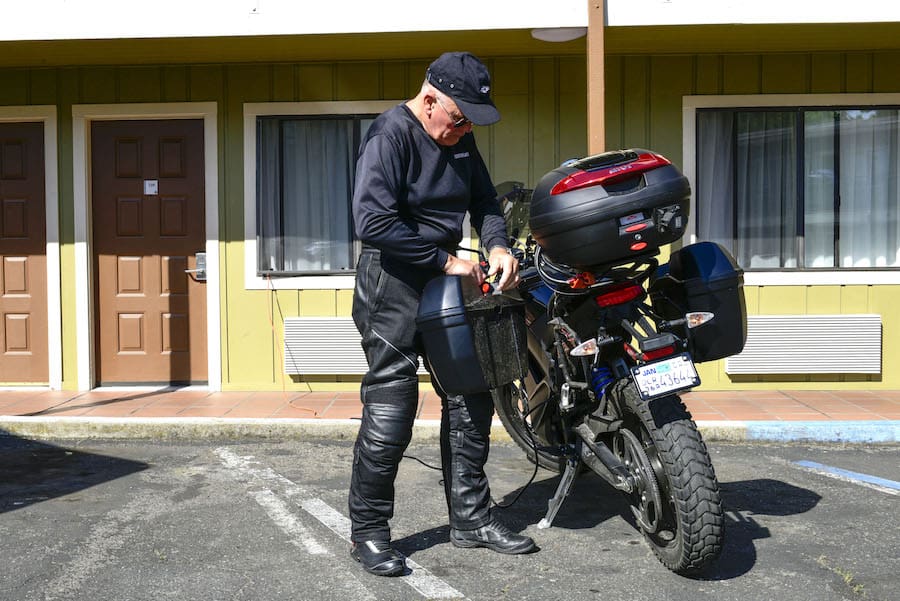
To recharge the Zero that night I plugged it into my motel room socket, and ran the extension lead through the window to the bike outside. Next morning the 24 per cent charge had been transposed into a full ‘tank’.

DAY 4
Parks and recreation
We covered the next 130km into the Sierra Nevada at sporting pace along the winding Highway 120 – another great biking road for exploiting the Zero’s beautifully mapped digital throttle that delivers thrilling performance in a liquid-smooth manner. I was impressed how responsive the 2016 Zero was with the reduced inertia in its new motor delivering great roll-on acceleration from 80km/h upwards to licence-losing levels. On the descent into Yosemite I saw the charge reading rise again, this time from 25 per cent to 34 right in front of me. With 19 per cent charge remaining as we rode into Half Dome Village after covering exactly 129km, I’d expect the dash’s claimed 53km of remaining range to be attainable – giving an overall range of 182km from a single charge at a good pace. Hooking up for a free recharge at one of the park’s surprisingly few EV recharging points restored that to 100 per cent in 90 minutes.
Yosemite National Park covers 2500km2 of area, though the majority of its four million visitors each year spend most of their time in the 20km2 of Yosemite Valley. Rising nearly 1500m above the valley and 2680m above sea level, the monolithic Half Dome is the iconic feature, and you’ll never forget it once you see it.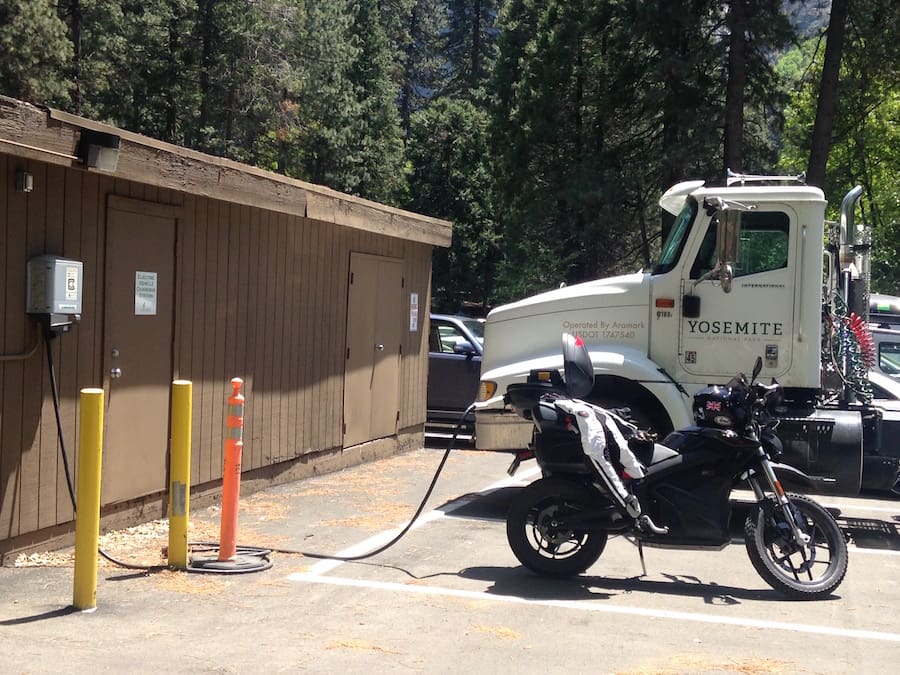
While gazing at the Half Dome I met United Airlines pilot Paul Fuell, who surveyed the DSR before telling me that “I didn’t expect to see a Zero up here!” Turned out he lives north of San Francisco in a Net Zero energy efficient house, with electricity provided by solar panels and windmills. He drives a BMW i3 and had considered buying a Zero four years ago, but was put off by the then restricted range of 70km in highway use. Reckon I made Zero a sale by showing him my trip book – he was especially impressed that I’d climbed Echo Summit!
“EVs are in the minority right now, but they’re in the ascendancy big time,” said Paul. “Twenty years from now the majority of new automobiles will be electric, because the ongoing development in battery technology will deliver convenience, as well as clean power. The only issue is how and where the electricity to power them will be generated, and our government needs to address
this urgently.”
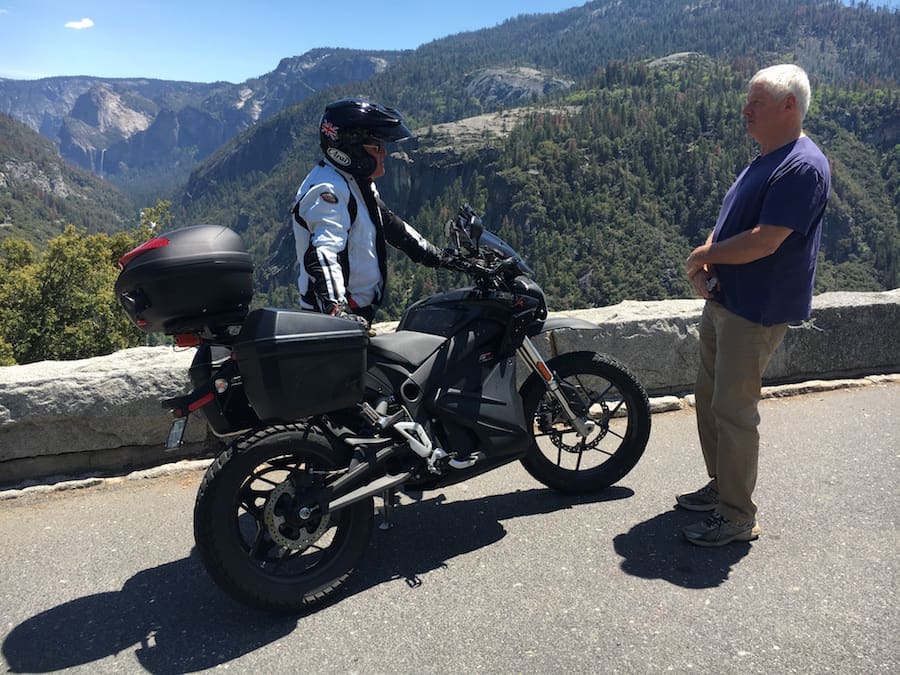
DAY 5
Where the legend began
After a day spent taking in Yosemite’s majestic scenery it was time to head back to the Pacific Coast, downhill through scenic Bear Valley (didn’t see Yogi, though), then on to the gradually descending road leading to Merced, 145km away in the San Joaquin Valley, California’s huge market garden. There I was invited to hook up by the large Toyota dealership which had no Prius models needing recharging, and also refused to accept any money. Thanks, guys. During the 90 minutes needed to fully recharge we had lunch at a nearby diner, then set off again heading for our overnight stop at Hollister, 130km away, where after a 275km day I recharged the bike’s batteries at a free hook-up behind the town hall, just round the corner from my motel room at the Hollister Inn.

We’d stopped for the night at this sleepy Californian farm town because in 1947 it was the scene of an alleged Fourth of July motorcycle gang riot which more than any one single other event in the USA gave rise to the widespread negative opinion of bikers in general, an attitude which persists today. This was compounded by the making of the controversial 1953 movie The Wild One starring Marlon Brando, based on the events of that evening in Hollister. Today, you can visit Johnny’s Bar & Grill downtown which was the actual café where the alleged riot started, and has numerous photos and memorabilia of the event and Brando’s movie. Plus it serves an excellent steak.
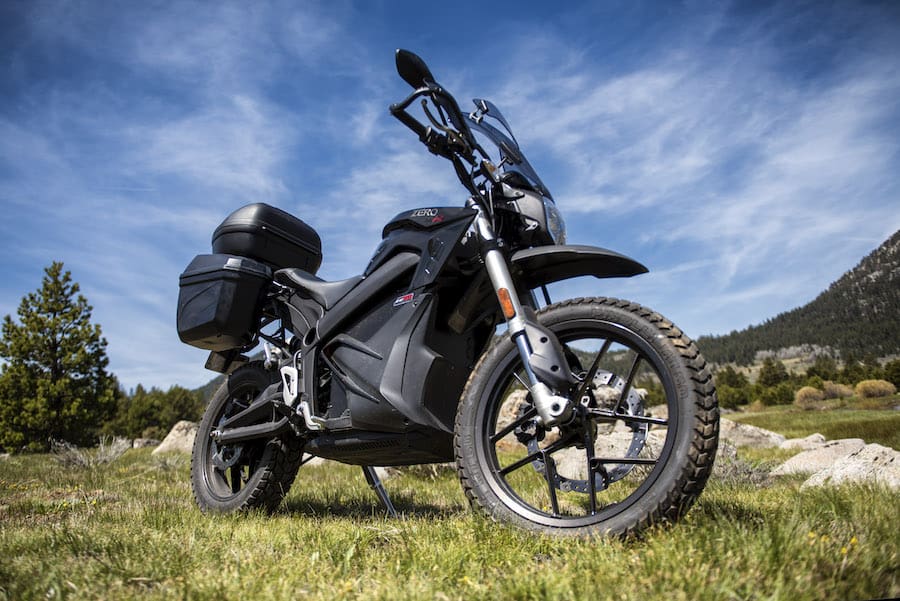
DAY 6
Homeward bound
Next day we headed over the hills to Monterey and nearby Carmel (where Clint Eastwood was formerly the mayor) for a look around, before riding back up the coast to Santa Cruz and the Zero Motorcycles factory at Scotts Valley, where I arrived with 13 per cent of charge remaining after a 158km ride. We had covered a total of 1434km in six days with no electrical or other mishaps, no running out of charge (just!), and the convenience of riding a twist-and-go machine with significant performance and much better handling than I was expecting – especially fully loaded. I needed no further convincing that Zero has succeeded in making electric motorcycles practical for the long haul. You do have to plan strategically, but in a way that’s part of the fun. And it’s the closest thing to free travel you’re ever going to get.
The development of electric motorcycles continues apace, but that shouldn’t be a surprise given the improvements in electronic and battery technology around us – just look at your cellphone and think back a mere six years to those pre-4G days, let alone two decades to those huge bricks we used to carry around. And when it comes to e-bikes, Zero’s products represent the benchmark.
